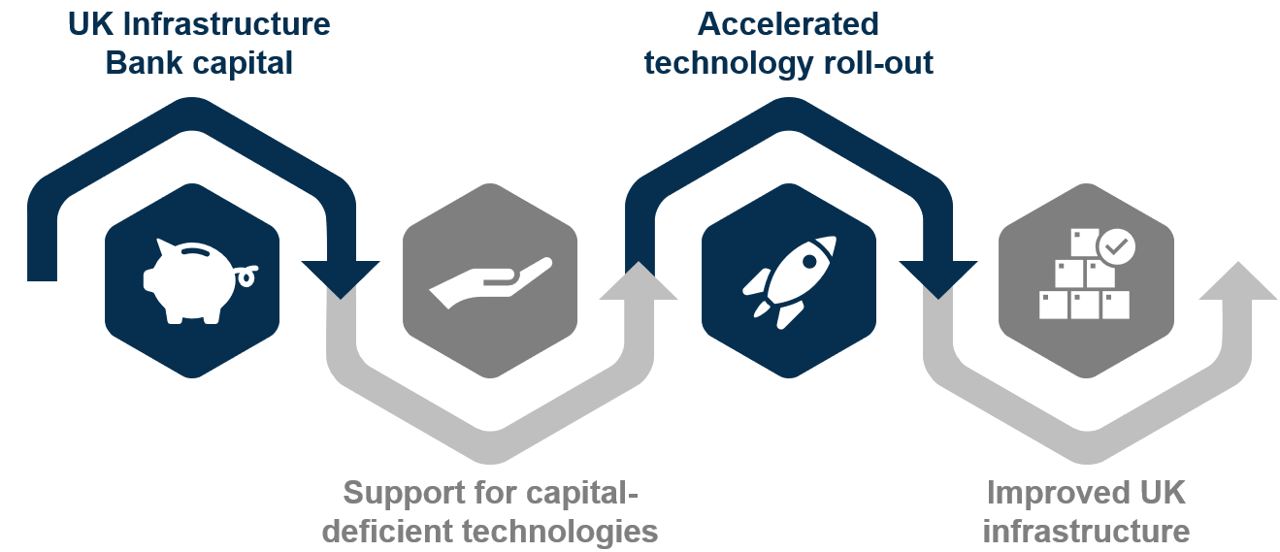The UK Infrastructure Bank: A Recipe For Success?
The UK Infrastructure Bank opened its doors on 17th June this year. The Bank, which is headquartered in Leeds, aspires to bolster investment towards capital-deficient infrastructure projects. In short, this government institution seeks to channel ‘billions of pounds… to support local growth and tackle climate change’ [1]. I think we can all agree that such funding is desperately needed!
The Bank boasts £12 billion of capital and a further £10 billion in available guarantees to support its environmental and economic ambitions [2]. The government expects the Bank to attract at least £40 billion of infrastructure investments.
While the Bank will target climate change mitigation and resilience, it also seeks to address all areas captured in the National Infrastructure Strategy: clean energy, transportation, water and waste, and digital infrastructure.
Although the messaging appears clear, the Bank’s long-term financial and operational capacity will ultimately determine its performance. In order to determine its potential for success, the key questions to address are:
What is the Bank’s focus?
How will the Bank operate?
Can it succeed?
Although we cannot judge the Bank’s success within a mere few weeks, we can discuss why the government believes this institution is necessary and how it may contribute to developing the UK’s infrastructure.
The Bank’s Focus: Addressing Capital Deficiencies in UK Infrastructure
Clearly, much of the UK’s infrastructure lacks the necessary funding to meet the requirements of present and future generations, particularly with regard to climate change. The COVID-19 pandemic has only compounded these preexisting funding/investment problems.
The Climate Change Committee identify that a further ~£50 billion of further capital is required each year to reach the government’s 2050 net-zero transmission objective. Legal and General highlight a £1 trillion UK infrastructure funding gap, which they believe can be partly remedied by investing up to £190 billion of direct benefit pension funds.
“The UK is already facing a £1 trillion infrastructure funding gap”
As the UK infrastructure market is highly privatised, its development (or underdevelopment) heavily depends on sustained private finance. The vast majority of the UK’s infrastructure is owned by private equity groups alongside pension, infrastructure and sovereign wealth funds. This is especially apparent in the utilities and energy sectors, which play a crucial role in environmental matters.
From Infrastructure and Projects Authority / HM Treasury [4]
Despite the private sector’s undeniable influence on UK infrastructure, investors often criticise the market as both ‘risky and unpredictable’ [5].
The Chancellor, Rishi Sunak, appears to agree.
The Bank, in collaboration with other public institutions, aspires to address many constraints which may lead to underinvestment in key infrastructure projects. The Leeds-based institution suggests that a private investment shortfall in underdeveloped or challenging markets has limited the UK’s adoption and adaption of key infrastructure technologies. Appropriately, the Bank’s Mission Statement emphasises its commitment to embracing ‘changes in market trends and technology’ to accelerate necessary development in key areas.
The Bank’s Operations: A Self-Sustaining Investment Model
To bolster private sector investment, the Bank’s private sector arm has the authority to offer loans and make investments in conjunction with the private sector. This institution has not been designed as a substitute for private sector investment. Rather, the chancellor’s strategy seeks to incentivise, supplement and sustain private funding. In particular, the Bank will focus on scaling early-stage technologies to bolster the adoption of innovative technologies in the UK infrastructure space.
How the UK Infrastructure Bank will support Britain’s infrastructure
Importantly, the Bank’s funds target projects which provide a financial return to ensure its longevity and deliver value for the taxpayer. The key mechanisms for engaging the private sector and delivering these objectives will be senior debt, equity, guarantees and hybrid products.
As with all financial institutions, the Bank’s success will depend on outcomes and how well its operating model works in practice. Sustainable results are key – without them, the wheels fall off.
The UK Infrastructure Bank’s model for longevity, sustainability and value outcomes
Beyond the private sector arm, the Bank will lend to local authorities across the UK to support their environmental sustainability efforts such as targeted investment projects and behavioural campaigns. The Bank further seeks to provide scrutiny of high value and complex projects to bolster quality and deliver sustainable value over time. In fostering collaboration, the government hopes to enable local actors to deliver on their own objectives while contributing to the UK’s wider infrastructure strategy.
The Verdict
Certainly, greater investment is required to meet National Infrastructure Strategy objectives, and both public and private institutions will be pivotal in doing so [6]. We can surely welcome greater investment for underfunded areas such as renewable energies and greater support for local environmental initiatives.
It remains to be seen whether current public funding, which is dwarfed by private sector investment, can close the £1 trillion infrastructure funding gap. As the Financial Times notes, the initial £12 billion funding appears to fall short of the monetary stimulus required to meet present and future needs [7].
Ultimately, the Bank’s success will depend on how its resources grow and whether this institution targets initiatives that bring tangible, sustainable benefits to UK infrastructure.
To find out more about Deecon’s experience in infrastructure please contact us.




